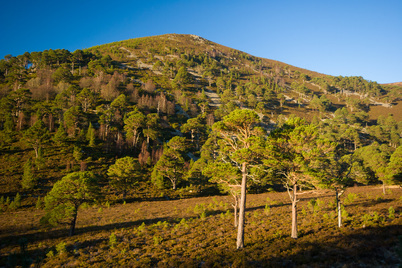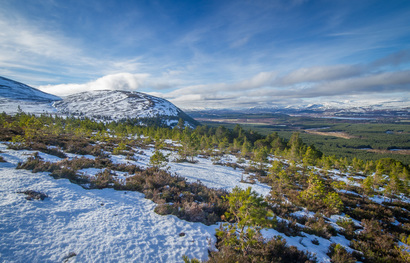 Meall a Bhuachaille, Glenmore, Cairngorms. By Colin Leslie.
Pine forest expanding up to 800m asl. Meall a Bhuachaille, Glenmore, Cairngorms. By Colin Leslie.
Pine forest expanding up to 800m asl.
The wide open vistas, heather moorlands and dramatic landscapes of the Scottish Highlands, and the deer that roam there, provide an iconic image of wildness.
But how natural is this landscape and how healthy? Only 5.1% of the land in the Highland area is native forest, and just 4% of this lies above 400m asl (see Native Woodland Survey of Scotland 2014). Forest would always have expanded and contracted with changing climatic conditions, especially at higher altitudes. Today at the upper margins we usually find a clear line between forest plantations at the timberline, with open land above; or where native woodland survives outside of fences, a few gnarled old trees clinging on, often in the inaccessible burns or on crags. There is a missing ecotone ... the treeline (sub alpine) and scrub (lower alpine) zones, where there would be a gradual change from the forest through krummholz (‘twisted wood’ in German) to the open land of dwarf shrubs above. Raising awareness of this situation is what the MSAG have been working on since 1996. The Benefits of Mountain Woodland:
Other useful pages:
Main photo: Creag Fhiaclach, Cairngorms. By Will Boyd Wallace.
Britain’s best example of a natural treeline. |
Mountain Woodland Action Group
*formerly the Montane Scrub Action Group The MSAG was set up in 1996 following a seminar organised through the Millennium Forest for Scotland project. A further conference in 2001, subtitled ‘the challenge above the treeline’ brought awareness of the situation to a range of stakeholders (see Gilbert 2002). The group is chaired by Sarah H. Watts and is a partnership of individuals supported by their organisations:
Best Practice Guides for Montane Scrub and treeline establishment and management of existing remnants are now available. Funding Scotland’s Forestry Grant Scheme: Woodland Creation, Native Low Density Option. This option, under Scotland’s FGS, offers support for treeline habitat creation. There is an initial planting grant and annual maintenance payments for five years; capital grants for fencing are also available. A maximum area of 10ha is eligible as a stand-alone option, or up to 25ha if in association with another option. MSAG would support interest in these applications. See: www.ruralpayments.org/publicsite/futures/topics/all-schemes/forestry-grant-scheme/woodland-creation/native-low-density-broadleaves Comparisons with Norway There is growing interest in a comparison between the Scottish Highlands, lacking in treeline and montane scrub habitats, and SW Norway which is a well-forested mountainous region where these habitats are ubiquitous. The two areas are very similar geologically and climatically but have a different land use history and current land management practices. See www.nordichorizons.org/the-nurturing-nature-event-resources.html | ||
| Montane Scrub Action Group | Mountain Woodland Action Group |
